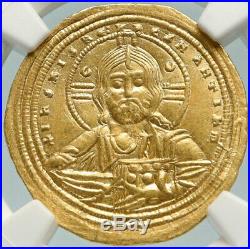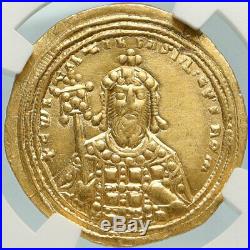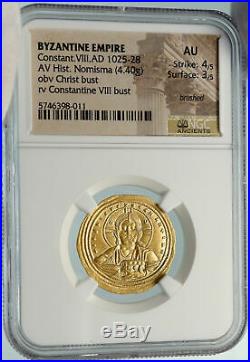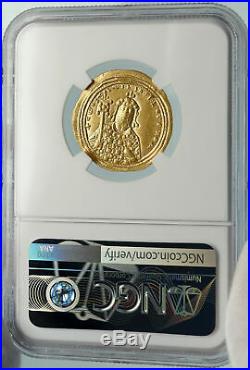





Item: i84780 Authentic Ancient Coin of. Reference: Sear 1815 Certification: NGC Ancients. AU Strike: 4/5 Surface: 3/5 5746398-011 Pedigree / Provenance: Ex CNG 115 (25 May 2005) #468 + IhS XIS RX RhANTIhM, bust of Christ facing, wearing nimbus cruciger with annulets in upper quadrants, pallium and colobium, raising right hand in benediction, Gospels cradled in left arm; triple border. +CNS-tANtIh bASILS ROm, facing bust of Constantine VIII, wearing crown with pendilia and square-pattern loros with jeweled collar, labarum in right hand, akakia in left; triple border. Jesus (7-2 BC to AD 30-33), also referred to as Jesus of Nazareth or Jesus Christ, is the central figure of Christianity, whom the teachings of most Christian denominations hold to be the Son of God. Christians believe Jesus is the awaited Messiah (or Christ, the Anointed One) of the Old Testament. Virtually all modern scholars of antiquity agree that Jesus existed historically, and historians consider the Synoptic Gospels (Matthew, Mark and Luke) to be the best sources for investigating the historical Jesus. Most scholars agree that Jesus was a Galilean, Jewish rabbi who preached his message orally, was baptized by John the Baptist, and was crucified by the order of the Roman Prefect Pontius Pilate. In the current mainstream view, Jesus was an apocalyptic preacher and the founder of a renewal movement within Judaism, although some prominent scholars argue that he was not apocalyptic. After Jesus’ death, his followers believed he was resurrected, and the community they formed eventually became the Christian church. The widely used calendar era, abbreviated as “AD” from the Latin “Anno Domini” (“in the year of our Lord”) or sometimes as “CE”, is based on the birth of Jesus. Christians believe that Jesus has a “unique significance” in the world. Christian doctrines include the beliefs that Jesus was conceived by the Holy Spirit, was born of a virgin named Mary, performed miracles, founded the Church, died by crucifixion as a sacrifice to achieve atonement, rose from the dead, and ascended into Heaven, whence he will return. Most Christians believe Jesus enables humans to be reconciled to God, and will judge the dead either before or after their bodily resurrection, an event tied to the Second Coming of Jesus in Christian eschatology; though some believe Jesus’s role as savior has more existential or societal concerns than the afterlife, and a few notable theologians have suggested that Jesus will bring about a universal reconciliation. The great majority of Christians worship Jesus as the incarnation of God the Son, the second of three persons of a Divine Trinity. A few Christian groups reject Trinitarianism, wholly or partly, as non-scriptural. In Islam, Jesus (commonly transliterated as Isa) is considered one of God’s important prophets and the Messiah, second in importance only to Muhammad. To Muslims, Jesus was a bringer of scripture and was born of a virgin, but was not the Son of God. According to the Quran, Jesus was not crucified but was physically raised into Heaven by God. Judaism rejects the belief that Jesus was the awaited Messiah, arguing that he did not fulfill the Messianic prophecies in the Tanakh. Constantine VIII Porphyrogenitus (Greek: , Knstantinos VIII) (960 – 11 November 1028) was de jure Byzantine Emperor from 962 until his death. He was the younger son of Emperor Romanos II and Empress Theophano. He was nominal co-emperor for 63 years, successively with his father; stepfather, Nikephoros II Phokas; uncle, John I Tzimiskes; and brother, Basil II. Basil II died childless on 15 December 1025 and thus left the rule of the Byzantine Empire in Constantine’s hands. Constantine had no interest in politics, statecraft or the military. His brief reign is said to have been “an unmitigated disaster”, sparking “a collapse of the military power of the Empire”. Constantine had no sons, so shortly before his death he married his daughter Zoë to his chosen successor, Romanos Argyros. Constantine’s father, Romanos II, was the sixth Byzantine emperor of the Macedonian dynasty. After the death of his first wife, Bertha (who took the name Eudocia), daughter of Hugh of Arles, he fell in love with and married an innkeeper’s daughter from the Peloponnese, Theophano. Contemporaries called Theophano the most beautiful woman in Christendom as well as ambitious, an inveterate schemer and utterly amoral. She bore Romanos four children, including Constantine, born in 960, and his elder brother Basil, born in 958. His sister Anna’s hand was considered such a prize that Vladimir I of Kiev converted to Christianity in order to marry her. Aged eight, Constantine was engaged to a daughter of Emperor Boris II of Bulgaria but in the end he married a Byzantine aristocrat, Helena, daughter of Alypius. By Helena he had three daughters: Eudokia, who became a nun; Zoë, who was empress for 22 years; and Theodora, who reigned for 18 months and was the last of the Macedonian line. Romanos died in 963, amidst rumours that Theophano had poisoned him; Constantine was three years old. Constantine and his brother had been crowned co-emperors by their father in March 962. The widowed Theophano installed herself as regent for her sons and promptly purged the imperial government, appointing her own men. Passing over a bevy of suitors among Constantinople’s courtiers, she made an alliance with Nikephoros Phokas. Nikephoros, a physically repulsive ascetic twice her age, was the greatest military hero of the Empire. In return for her hand, the childless Nikephoros gave his sacred pledge to protect her children and their interests. Nikephoros entered Constantinople three months after Romanos’ death, breaking the resistance of Joseph Bringas, a eunuch palace official who had been Romanos’ chief counsellor, in street fighting. Nikephoros was crowned emperor in the presence of his nominal co-emperors, Constantine and Basil. A month later he married their mother. Six years later, Nikephoros was murdered at Theophano’s instigation and her lover and co-conspirator John Tzimiskes was acclaimed emperor. Tzimiskes proposed to marry Theophano but the Empress had by then been too damaged by gossip and rumours, many of them accurate. Patriarch Polyeuktos refused to perform the coronation unless Tzimiskes removed the “scarlet empress” from the court. Tzimiskes calculated that his legitimacy would be better enhanced by church approval than betrothal to the unpopular empress and acceded to the Patriarch’s demands. Theophano was sent into exile and Tzimiskes was crowned, again with Constantine and Basil as co-emperors. He married Theodora, Constantine’s aunt. Following the death of Tzimiskes in January 976, Basil and Constantine took power. Although the sixteen year old Constantine was nominally co-emperor it was clear that Basil was senior emperor as Basileus Basil II. Constantine as a young man was tall and graceful, he was a superb horseman and trained his own horses. He competed in athletic and wrestling competitions, which he brought back into fashion. He had an excellent speaking voice and a good grasp of rhetoric. He was a gourmet and a gourmand. He had no interest in politics, statecraft or the military and never developed any. Constantine led troops alongside his brother in 989; the campaign ended without any combat and Constantine was not appointed to military command again. Basil II had an illustrious reign, earning the sobriquet “Bulgar-slayer” (Bulgaroktonus). He died childless on 15 December 1025 and Constantine, a sixty-five-year-old widower, became sole emperor as Constantine VIII. He had been a co-emperor for sixty-three years but had always been content to enjoy the privileges of imperial status, without concerning himself with state affairs. He spent his life in the search of pleasure and entertainment, or amusing himself with riding and hunting. He was of frivolous disposition, he desired nothing more than to pass his life wallowing in extravagant pleasures. Constantine as emperor carried on as he always had – hunting, feasting, and enjoying life – and avoided state business as much as possible. By the time he became emperor he had chronic gout and could hardly walk. He met challenges with impulsive cruelty, persecuting the nobility and ordering an orgy of torture; blinding was a favoured punishment for crimes real or imagined. He filled the senior court and state positions with nonentities. Within months the land laws of Basil II were dropped, under pressure from the Anatolian aristocracy. “Devoid of any semblance of moral fibre” he would grant any concession. Favouritism failed to win him friends and he persecuted the nobility when he felt threatened by conspiracy. The start of the decline of the Byzantine Empire has been linked to Constantine’s accession to the throne. His reign has been described as “an unmitigated disaster”, “a break up of the system” and causing “a collapse of the military power of the Empire”. He ruled for less than three years before his death on 11 November 1028. On his deathbed, and without a male heir, Constantine recalled the senior aristocrat Constantine Dalessenos, Duke of Antioch, to the capital in order to marry his daughter Zoë. The Dalassenus were one of the few powerful patrician families who had been unswervingly loyal to the Macedonian dynasty. Constantine Dalassenos set out from his estates in the Armeniac Theme, but before reaching Constantinople the situation changed: the emperor’s advisors preferred a weak ruler whom they could control, and, typically, Constantine was persuaded. He choose Romanos Argyros instead, forcing him to divorce his wife and marry Zoë. The wedding took place only three days before Constantine died on 11 November 1028. Romanos was crowned Romanos III r. World-renowned expert numismatist, enthusiast, author and dealer in authentic ancient Greek, ancient Roman, ancient Byzantine, world coins & more. Ilya Zlobin is an independent individual who has a passion for coin collecting, research and understanding the importance of the historical context and significance all coins and objects represent. Send me a message about this and I can update your invoice should you want this method. Getting your order to you, quickly and securely is a top priority and is taken seriously here. Great care is taken in packaging and mailing every item securely and quickly. What is a certificate of authenticity and what guarantees do you give that the item is authentic? You will be very happy with what you get with the COA; a professional presentation of the coin, with all of the relevant information and a picture of the coin you saw in the listing. Additionally, the coin is inside it’s own protective coin flip (holder), with a 2×2 inch description of the coin matching the individual number on the COA. Whether your goal is to collect or give the item as a gift, coins presented like this could be more prized and valued higher than items that were not given such care and attention to. When should I leave feedback? Please don’t leave any negative feedbacks, as it happens sometimes that people rush to leave feedback before letting sufficient time for their order to arrive. The matter of fact is that any issues can be resolved, as reputation is most important to me. My goal is to provide superior products and quality of service. How and where do I learn more about collecting ancient coins? Visit the Guide on How to Use My Store. For on an overview about using my store, with additional information and links to all other parts of my store which may include educational information on topics you are looking for. The item “CONSTANTINE VIII 1025AD Gold Ancient Byzantine Coin w JESUS CHRIST NGC AU i84780″ is in sale since Sunday, June 7, 2020. This item is in the category “Coins & Paper Money\Coins\ Ancient\Byzantine (300-1400 AD)”. The seller is “highrating_lowprice” and is located in Rego Park, New York. This item can be shipped worldwide.
- Certification Number: 5746398-011
- Certification: NGC
- Grade: AU

